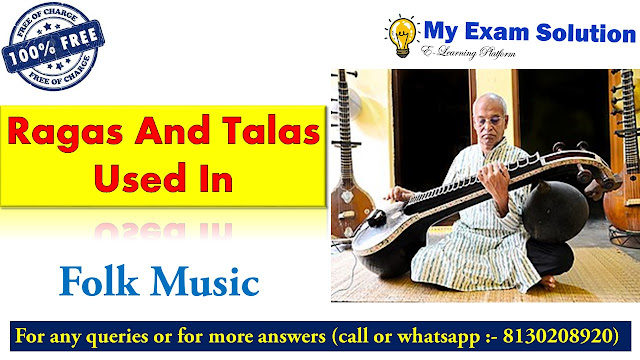Ragas and Talas used in folk music
Ragas and talas are important musical concepts in Indian
classical music and are also used in some forms of Indian folk music.
A raga is a melodic framework used in Indian classical music
that defines the structure and mood of a piece of music. A raga consists of a
series of notes, or swaras, that are used in a specific order and with specific
rules regarding their use, such as which notes can be used for which sections
of the music, how the notes should be approached, and how they should be
decorated.
A tala is a rhythmic pattern that serves as the foundation for a piece of music. A tala is made up of a series of beats, or matras, that are played in a specific order, and is used to provide structure and continuity to the music.
In Indian folk music, ragas and talas are often used in a simplified form, with less strict rules regarding their use. This allows for more improvisation and flexibility in the music, reflecting the dynamic and spontaneous nature of folk music.
The use of ragas and talas in Indian folk music varies
depending on the region and style of music, but they are an important part of
the musical heritage of India and are used to create unique and expressive
musical styles.
What are the ragas used in folk music
The ragas used in Indian folk music vary depending on the
region and style of music. However, some of the most commonly used ragas in
Indian folk music include Bhairav, Bhoop, Chaiti, Jaunpuri, Kafi, Kalyan,
Malkauns, and Bhimpalasi.
These ragas are often used in simplified forms, with less
strict rules regarding their use, allowing for more improvisation and
flexibility in the music. The ragas used in Indian folk music are also often
influenced by local musical traditions, and may incorporate regional or
cultural elements that are unique to a particular area.
It's important to note that the use of ragas in Indian folk
music may differ from their use in classical Indian music, where the ragas are
more strictly defined and have specific rules regarding their use. In folk
music, the ragas are often used as a starting point or foundation, with more
improvisation and variation added to create a unique and expressive musical
style.
What is raga and tala
Raga and Tala are two important concepts in Indian classical
music.
A raga is a melodic framework used in Indian classical music
that defines the structure and mood of a piece of music. A raga consists of a
series of notes, or swaras, that are used in a specific order and with specific
rules regarding their use, such as which notes can be used for which sections
of the music, how the notes should be approached, and how they should be
decorated. Each raga is associated with a specific time of day or mood, and is
used to create a particular atmosphere or emotional effect in the music.
A tala is a rhythmic pattern that serves as the foundation
for a piece of music. A tala is made up of a series of beats, or matras, that
are played in a specific order, and is used to provide structure and continuity
to the music. The tala provides a rhythmic framework for the music and serves
as a basis for the improvisation that is a key part of Indian classical music.
Together, the raga and tala form the foundation for a piece
of Indian classical music, providing both a melodic and rhythmic structure that
the performer can use to create a unique and expressive musical performance.
What are the 7 ragas
The number of ragas in Indian classical music is extensive
and varies depending on the tradition and style of music. However, some of the
most commonly recognized ragas in Indian classical music include:
- Bhairav
- Bhoop
- Kafi
- Malkauns
- Darbari
- Megh
- Todi
These are just a few examples of the many ragas used in
Indian classical music, each of which has its own unique musical
characteristics and associated moods or emotions. It's important to note that
the use of ragas in Indian classical music is highly nuanced and complex, and
that a deep understanding of the musical traditions and cultural context is
necessary to fully appreciate their significance.
ALSO READ:-
Folk Music Origin, evolution and classification of Indian folk song / music
Whatsapp :- 8130208920
Youtube :- Myexamsolution







0 comments:
Note: Only a member of this blog may post a comment.